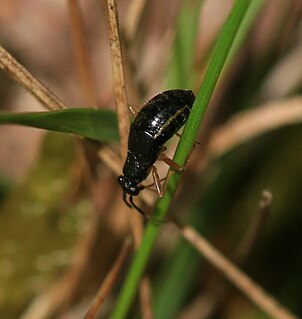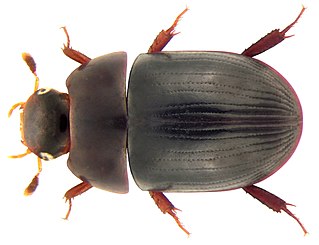
Lymantria dispar, the gypsy moth, is a species of moth in the Erebidae family. Lymantria dispar is subdivided into several subspecies, with subspecies such as L. d. dispar and L. d. japonica being clearly identifiable without ambiguity. Lymantria dispar has been introduced to several continents and is now found in Europe, Africa, Asia, North America and South America. The polyphagous larvae live on a variety of deciduous and coniferous trees and can cause severe damage in years of mass reproduction. Due to these features, the gypsy moth is listed among the world's 100 most invasive alien species.

Ichthyornis is an extinct genus of toothed seabird-like ornithuran from the late Cretaceous period of North America. Its fossil remains are known from the chalks of Alberta, Alabama, Kansas, New Mexico, Saskatchewan, and Texas, in strata that were laid down in the Western Interior Seaway during the Turonian through Campanian ages, about 95–83.5 million years ago. Ichthyornis is a common component of the Niobrara Formation fauna, and numerous specimens have been found.

Lymantria dispar dispar, commonly known as the gypsy moth, European gypsy moth, or North American gypsy moth, is a species of moth in the family Erebidae that is of Eurasian origin. It has a range that extends over Europe, Africa, and North America.
Ischyropalpus is a genus of antlike flower beetles in the family Anthicidae. There are about 15 described species in Ischyropalpus.
Epeorus dispar is a species of flatheaded mayfly in the family Heptageniidae. It is found in North America.

Pentaria trifasciata is a species of false flower beetle in the family Scraptiidae. It is found in North America.

Pentaria is a genus of false flower beetles in the family Scraptiidae. There are about nine described species in Pentaria.
Chrysanthrax dispar is a species of bee fly in the family Bombyliidae.

Trapezonotus is a genus of dirt-colored seed bugs in the family Rhyparochromidae. There are about 19 described species in Trapezonotus.

Hoplia dispar is a species of scarab beetle in the family Scarabaeidae. It is found in North America.
Smicridea dispar is a species of netspinning caddisfly in the family Hydropsychidae. It is found in North America.
Sceptobius is a genus of rove beetles in the family Staphylinidae. There are at least three described species in Sceptobius.
Hister dispar is a species of clown beetle in the family Histeridae. It is found in North America.

Thanatophilus is a genus of carrion beetles in the family Silphidae. There are about 12 described species in Thanatophilus.

Mecomma is a genus of plant bugs in the family Miridae. There are more than 30 described species in Mecomma.

Dactylosternum is a genus of water scavenger beetles in the family Hydrophilidae. There are more than 20 described species in Dactylosternum.
Sceptobius dispar is a species of rove beetle in the family Staphylinidae. It is found in Central America and North America.

Microcara is a genus of marsh beetles in the family Scirtidae. There are about 10 described species in Microcara.
Ampumixis is a genus of riffle beetles in the family Elmidae. There is one described species in Ampumixis, A. dispar.
Glyphidops is a genus of cactus flies in the family Neriidae. There are at least 20 described species in Glyphidops.










